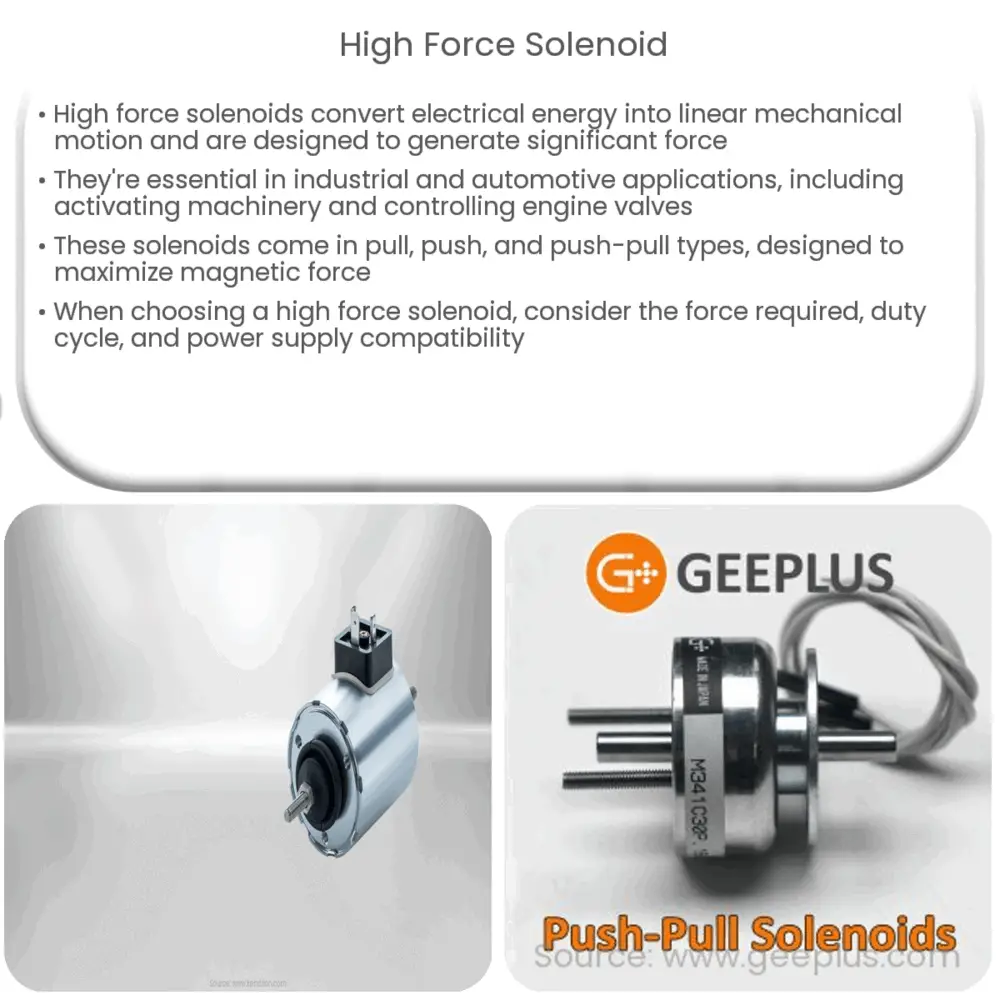Explore the principles, types, and applications of high force solenoids in various industries, along with key selection considerations.

Introduction to High Force Solenoids
Understanding the principles and applications of a high force solenoid is crucial for anyone interested in the field of electromechanical engineering. A solenoid is an electromechanical device that converts electrical energy into linear mechanical motion. Its basic structure comprises a coil of wire wound around a movable plunger, within a cylindrical housing.
High force solenoids, as the name implies, are specially designed solenoids capable of generating a significant amount of force. They are often used in industrial applications where a high level of force is required to drive mechanical systems or to overcome a high level of resistance.
Working Principle
The working principle of a high force solenoid is the same as that of a regular solenoid. When an electrical current is applied to the coil of wire, it creates a magnetic field within the coil. This magnetic field exerts a force on the plunger, causing it to move in a direction either into or out of the coil, depending on the design. The main difference with a high force solenoid is in its design and construction, which enables it to produce a much higher force than a standard solenoid.
Applications
Industrial Automation: High force solenoids are commonly used in industrial automation processes where large forces are required for the operation of machinery. They can be used to activate heavy-duty switches, to drive large mechanical components, or to operate valves in high-pressure systems.
Automotive Industry: In the automotive industry, high force solenoids can be found in applications such as shifting gears in automatic transmissions, activating braking systems, or controlling engine valves.
The above applications are just a few examples of where high force solenoids are used. These solenoids offer several advantages, such as high reliability, simple design, and the ability to produce a large amount of force, which makes them suitable for a wide range of applications.
Understanding the principles behind high force solenoids, their design, and their many applications can help us appreciate the significant role these devices play in our daily lives. In the next part, we will delve deeper into the types, construction, and considerations when choosing a high force solenoid.
Types and Construction
High force solenoids come in various types, which are usually categorized based on their operating principles or their construction. The most common types include pull type, push type, and push-pull type solenoids. The pull type solenoids pull the plunger in when energized, the push type pushes the plunger out when energized, and the push-pull type can do both depending on the direction of current.
The construction of high force solenoids is designed to maximize the magnetic field and, consequently, the force produced. This often involves using a larger coil or a material with high magnetic permeability for the plunger and the housing. Additionally, high force solenoids often have a specially designed return spring to reset the plunger position when the current is switched off.
Considerations when Choosing a High Force Solenoid
There are several factors to consider when choosing a high force solenoid for a particular application. These include:
Force Required: The primary consideration is the amount of force required. This will depend on the specifics of the application and the resistance that the solenoid has to overcome.
Duty Cycle: The duty cycle of a solenoid refers to the percentage of time that it can remain energized without overheating. For applications where the solenoid will be continuously or frequently energized, a high duty cycle solenoid may be necessary.
Power Supply: The power supply available will also impact the choice of solenoid. Solenoids are designed to operate at specific voltages, so it’s important to choose a solenoid that matches the power supply.
Conclusion
In conclusion, high force solenoids are powerful and versatile electromechanical devices that play a crucial role in various industries, from industrial automation to the automotive industry. Understanding their working principles, types, construction, and the considerations when choosing one, can help engineers and designers make the most effective and efficient use of these devices. As technologies continue to evolve, we can expect to see the development of high force solenoids with even greater capabilities and efficiencies, further expanding their potential applications.

